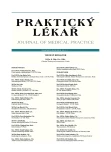Strategy of antiaggregation treatment after percutaneous coronary interventions
Authors:
P. Toušek; V. Kočka
Authors‘ workplace:
III. Interní-kardiologická klinika FN Královské Vinohrady a 3. lékařské fakulty UK, Praha, Přednosta: prof. MUDr. Petr Widimský, DrSc., FESC.
Published in:
Prakt. Lék. 2012; 92(1): 8-10
Category:
Reviews
Overview
The basal treatment of patients after a percutaneous coronary intervention (PCI) consists of administration of acetylosalicylic acid and thienopyridines, so called dual antiaggregation therapy. Recommended length of dual antiaggregation therapy depends on clinical situation and type of implanted stent. During the treatment, it is necessary to take into account various co-morbidities and to often react to particular clinical situations.
This review aims to make general practitioners familiar with guidelines on antiaggregation therapy after PCI and to show possible solutions in the treatment strategy in various clinical situations requiring an individualized approach.
Key words:
percutaneous coronary intervention, dual antiaggregation therapy, bleeding, individualized approach.
Sources
1. Želízko, M., Vojáček, J., Kala, P. a kol. Přehled vybraných kardiovaskulárních intervencí v České republice 2008. Praha: ÚZIS ČR. NRKI 2011 (ISSN 1803-8603, ISBN 978-80-7280-855-7).
2. Wijns, W., Kolh, P., Danchin, N. et al. Guidelines on myocardial revascularization. Eur. Heart J. 2010, 31, p. 2501-2555.
3. Hamm, C.W., Bassand, J.P., Agewall, S. et al. ESC Guidelines for the management of acute coronary syndromes in patients presenting without persistent ST-segment elevation: The Task Force for the management of acute coronary syndromes (ACS) in patients presenting without persistent ST-segment elevation of the European Society of Cardiology (ESC). Eur. Heart J. 2010, 32, p. 2999-3054.
4. Steg, P.G., Huber, K., Andreotti, F. et al. Bleeding in acute coronary syndromes and percutaneous coronary interventions: position paper by the Working Group on Thrombosis of the European Society of Cardiology. Eur. Heart 2011, 32, p. 1854-1864.
5. Lip, G., Huber, K., Andreotti, F. et al. Antithrombotic management of atrial fibrillation patients presenting with acute coronary syndrome and/or undergoing coronary stenting: executive summary - a consensus document of the European Society of Cardiology Working Group on Thrombosis, endorsed by the European Heart Rhythm Association (EHRA) and the European Association of Percutaneous Cardiovascular Interventions (EAPCI). Eur Heart. J. 2010, 31, p. 1311-1318.
6. Vahanian, A., Auricchio, A., Bax, J.J. et al. Guidelines for pre-operative cardiac risk assessment and perioperative cardiac management in non-cardiac surgery. Eur Heart. J. 2009, 30, p. 2769-2812.
7. To, A.C., Armstrong, G., Zeng, I. et al. Noncardiac surgery and bleeding after percutaneous coronary intervention. Circ. Cardiovasc. Interv. 2009, 2, p. 213-221.
8. Wallentin, L., Becker, R., Budaj, A. et al. Ticagrelor versus clopidogrel in patients with acute coronary syndromes. N. Engl. J. Med. 2009, 361, p. 1045-1057.
9. Paulů, P., Toušek, P., Osmančík, P. Antiagregační léčba – přehled preparátů, možnosti stanovení rezistence na léčbu a její přínos klinické praxi. Prakt. Lék. 2011, 91(2), p. 73-76.
Labels
General practitioner for children and adolescents General practitioner for adultsArticle was published in
General Practitioner

2012 Issue 1
- Memantine Eases Daily Life for Patients and Caregivers
- Metamizole vs. Tramadol in Postoperative Analgesia
- Metamizole at a Glance and in Practice – Effective Non-Opioid Analgesic for All Ages
- Memantine in Dementia Therapy – Current Findings and Possible Future Applications
- What Effect Can Be Expected from Limosilactobacillus reuteri in Mucositis and Peri-Implantitis?
Most read in this issue
- Current role of endoscopic ultrasound investigation in the diagnosis of pancreatic diseases – our experiences
- Psychoactive substances abuse and diabetes mellitus
- Potentially inappropriate (risky) drugs at geriatric patients Expert consensus for the Czech Republic 2012
- A survey of motivational factors in non-medical health professionals
